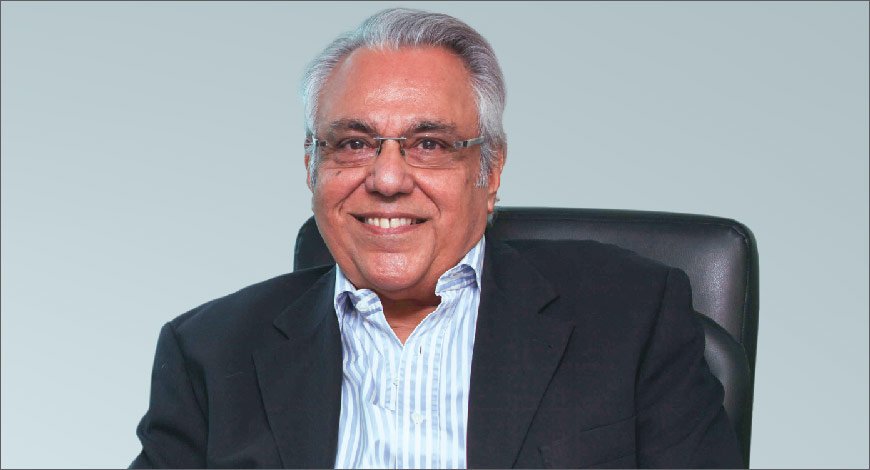For years, they had staved off bids by the erstwhile CEO of WPP, Sir Martin Sorrell, to increase his stake in Rediffusion from the 26.7% he already held through Y&R. “Not now, not ever,” Nanda is believed to have told Sir Martin in 2007. More than a decade later - incidentally with Sir Martin out of the scenario - Nanda’s move to regain control of the agency is being seen as a serious re-entry and repositioning of Rediffusion in the business, having warmed up in the last couple of years by infusing new talent, winning new accounts and priming it to face the tech-first world leveraging the strength of the home-grown digital platform, rediff.com.
Nanda is a legend unto himself. Stories abound of his strict ethics and refusal to bow down with misgivings at any point. In the 1970s, The Sunday magazine was being launched out of Calcutta, with M J Akbar as editor. It was priced four times the price of the leading magazine of that time, which was India Today, as there were going to be people of the caliber of Satyajit Ray writing on films, MAK Pataudi commenting on sports, and so on. As the agency associated with the launch, Rediffusion did an introductory campaign for the first issue pre-launch. Its provocative lines apparently created a huge stir. But when Nanda finally saw the first issue, he was extremely disappointed, because what the campaign promised the customer was not what the product delivered. He just picked up the phone, called his client and resigned the business. It’s another matter that the magazine’s copies got sold out in a few hours and it had to be reprinted three times. “The point is responsibility. As somebody doing the advertising, you can’t be responsible for the quality of all your products, but you have a responsibility when you boldly say something and don’t deliver. In that situation what do you do? At least I thought it was right to quit,” Nanda recalls.
In another instance, Rediffusion was working with Reckitt Coleman on brands like Robin Blue, the whitener, etc., when there was a change in management there. The new marketing director did not get along with the person servicing the business and requested Nanda to remove him just for that reason. “If there is an issue of quality, I have no problem. I will remove the individual. But, if you do not like somebody, that is not good enough reason for me to remove him, because that is not fair,” Nanda remembers telling the gentleman. The next thing he did was to resign on the business. “You stand by what you say. These things for me are very crucial.”
It is a delight talking to Diwan Arun Nanda, getting a sense of the principles that guide his vision for Rediffusion. Here are excerpts from a conversation with IMPACT, in which he tells us how he will go about reinventing Rediffusion and building its capabilities to suit the demands of today’s advertising world.
Q] How does it feel to be in full control of Rediffusion once again?
What were some of your thoughts as the buyback deal was finalized? It feels great. After a long time we will now have a no-conflict situation, no conflict of any kind, either on clients or business. It feels liberating, because as you know, we were independent for many years, until 1994. Then we sold our stake to Dentsu and Y&R separately. And then WPP bought Y&R’s share in the year 2000, when they bought Y&R as a company. So, they became our shareholders. But, how has it been? It’s been very good.
Q] What will be your immediate focus areas now?
My focus areas are pretty clear – 1. Business growth 2. Better integration between advertising, Direct and the new technologies, especially Internet 3. Deliver the total package to any client, not segmented packages of Print advertising somewhere and Television or Outdoor somewhere else, etc., but the complete package of communication needs of any client.
Q] Are you going to revisit some of the old marquee client relationships such as Colgate and Airtel, and try to win them back?
Colgate is now a Red Fuse client. Now that is internationally aligned in many countries. So, that takes care of Colgate. Coming to other clients, I am very clear - we will welcome all like-minded clients who want to build their brands long term - not just a oneoff product, not just a one-off campaign - in today’s extremely challenging marketing environment. We started with this credo, and we are staying with it.
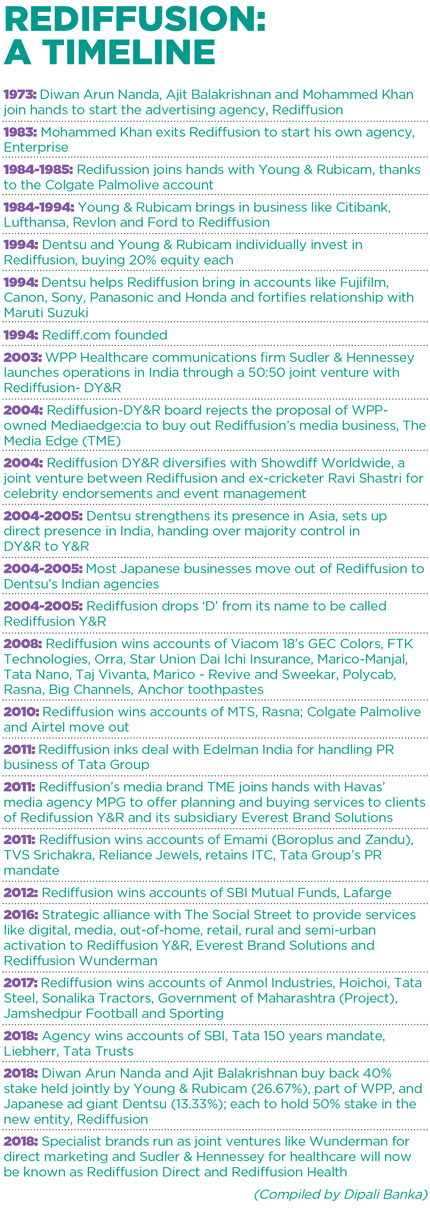 Q] You recently appointed Rahul Jauhari and Navonil Chatterjee as Joint Presidents. What are your expectations from them? Will there be other fundamental changes in organizational structure?
Q] You recently appointed Rahul Jauhari and Navonil Chatterjee as Joint Presidents. What are your expectations from them? Will there be other fundamental changes in organizational structure? First and foremost, I expect business with ethics. We have always been known to be a very ethical company. Number two, never compromise on your principles, irrespective of monetary gain or loss. Number three, always hire and keep talent in the company, especially in the area of creative and strategy. Number four, very important part of our history and ethos, let there be freedom for all to give and share. We don’t operate hierarchies in the sharing or exchange of ideas. You can be the juniormost individual in the department, but if you have a good idea, you should expose it to everybody else. Therefore, this equality of thought should be without any fear of rank. I have had over the years peons come and tell me, ‘Sir, I have a very good idea for this product’.
Q] What is the outlook for Rediffusion Healthcare and Rediffusion Direct?
Aditya Mehrish runs Rediffusion Direct and Dr Sujata Mahadik runs Rediffusion Healthcare as Presidents. Mahadik is a qualified doctor and deals with pharmaceutical clients. In Direct, we had the tie-up with Wunderman, but now that’s no longer there. They have clients in India and out of India. For example, Ooredoo is a very large operator out of the Middle East; it is not based here. Going forward, I expect more synergy with them.
Q] You are an IIM-A alumnus and always recruited high quality talent. Does it bother you that the advertising industry today no longer attracts the level of talent that it did earlier?
It bothers me a lot, only in one way. Generally the level of talent in India has gone up substantially from the time I graduated from IIM Ahmedabad in the early 1980s. I don’t see much difference between a graduate or postgraduate of institute A versus institute B. Of course, there are A level and B level management institutes. But, the top 10 institutes offer education that is roughly similar. Now, the question is, where do we find the talent? Advertising is not a preferred option for people who come out of business schools today because advertising does not seem to be able to afford the entry level salaries of these postgraduates. So, we start going to the second tier of management institutes, where the quality is also very high. You have the MICAs of the world that are turning out outstandingly talented students. So, I don’t see a shortage of talent. You have to spot talent and get the right people in.
Q] What are the ‘must have’ qualities for a new recruit at Rediffusion?
First and foremost, the person has to have the passion to excel in their work. Second, I would look for business ethics. And third, the person has to be fearless, very fearless because in this competitive world, being subdued doesn’t help. You have to stand up for your ideas, and you have to give them, irrespective of what the receiver takes away. That to me is crucial. And today’s generation seems to have that spunk, which I think is exceptional.
Q] When Rediff.com launched in 1994, it was a pioneer. No one in India had even thought of digital or understood it. But, today, how does it navigate the digital world? What are your plans for Rediff.com?
Rediff.com and Rediffusion, the agency, are now getting pretty closely aligned. There are presentations we make jointly. When the task is predominantly Internet-based, digital, then Rediff.com comes in, in a big way. They have got close to 200 software experts, and they are doing a lot of highly sensitive work, some for the Government, which I can’t talk about.
Q] Now, we see consultancies like Deloitte, PWC, Accenture, etc., gaining a foothold in the advertising domain. What is your sense of the market with competition from these tech companies?
They are here to stay. Ultimately, it boils down to only one thing - what is the quality of your idea? The idea is the one that sells. The idea has to move the customer and move the brand. I am not afraid of competition from them. If they get better ideas on something, they are welcome. I personally will applaud the idea.
Q] What are the challenges you see, going forward?
The biggest challenge is to make sure that the standard quality of the thinking and creating is not in any way diluted. The standard of thought is the only thing you have. The rest is our leased or owned or rented space. And the creative agency business, strategic business is not of desks and chairs. This is of the mind. It is the ideation that comes from the mind. So, this should not get eroded under any circumstances.
Q] Would you look at acquisitions to grow the Rediffusion Group in future?
As I said, if a company is like-minded, no issue at all. But, ethics must be the same.
Q] Today, viewership of content and ads is shifting to devices even as people have shorter and shorter attention spans. What kind of challenge is advertising in this scenario? How do you address it?
I don’t think that is a new challenge at all. Advertising has always been an unwanted intrusion on the customer. You don’t put on TV channels to see an ad. You put on a TV channel because you want to watch a programme. So, advertising has competed for attention span with content right through. No change there. The kind of content has changed. Today, you have devices that give you the content. Anybody using that device doesn’t want to see ads. We still need attention. We still need to entice the consumer, get him or her interested. They must then get a positive feeling towards you; it has to be done in the flash of five seconds, 10 seconds. So, the onus on delivery is high. In the earlier days, you used to have more time for people to scan and look. Today, the attention span is less. But, the challenge is exactly the same as when I entered advertising.
Q] You set up Rediffusion in 1973. Forty-five years down the line, how do you assess the agenda of what you set out to do at Rediffusion?
We set out to stand apart from everybody else, not by talking about it, but by creating work that talked about itself. We did not want to be known for what we did, but preferred the work to be known. What mattered to us - and still does – is did the viewer respond to the communication? That has not changed.
Q] There are instances of you clearly standing up and saying no where your ethics did not match your client’s; you even resigned on some businesses. Does that work in today’s world of cut-throat competition?
If you subjugate yourself and accept somebody’s suggestion just because it is convenient, you are not doing your industry or yourself a favour. But, the organization has to back you. You can’t do it without the backing of your company.
Q] How do you see the media and advertising industry of today compared to the days of the Mad Men?
It is becoming more and more transactional. But, over time, you will find that those who stand tall and stand firm are the Mad Men. And they will survive, because they bring to the table talent, they bring to the table ideas, they bring to the table a way of working that few people can match. So, the years of the Mad Men will continue… may be not as widely as it used to, but they will be there.
Q] If we ask you to describe yourself in one word,
what would your answer be?
Fearless.
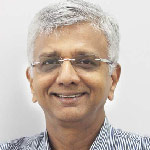 MY REDIFFUSION DAYS…
MY REDIFFUSION DAYS…Ambi Parameswaran harks back to the time in the late 1970s when he interned at Rediffusion and then joined the agency as a management trainee, in possibly the first ever management training programme in the Indian ad world
It was April 1978 and I was at IIM Calcutta, looking for a suitable summer internship. I was keen on an internship that was Calcutta-based and the choice was rather limited. I stumbled upon an innocuous note in the placement notice board saying that a small agency headquartered in Bombay was looking for a summer intern to work out of their Calcutta office. I applied and that was the first time I met the co-founder of Rediffusion Advertising, Ajit Balakrishnan and Subhas Chakravarty, branch director of Rediffusion Calcutta. It turned out that both were alumni of IIM-C and were wondering if fresh IIM graduates could be inducted into their small company. I think the fact that both of them were IIM-C alumni kind of clinched the deal. I agreed to do my internship at Rediffusion Calcutta on a then esoteric topic of ‘Simulation Model for Media Planning’.
As a summer intern, I was given the freedom to work from campus or come to the office at Camac Street, if my memory serves me right. It was a research project that involved studying numerous papers and these were obviously to be found in the IIM-C library. But I was welcome to visit the office every day, if need be. I remember seeing the layouts for some of the legendary campaigns that were being hatched by the agency (remember ‘Whenever You See Colour Think Of us’) campaigns that were being presented to Calcutta-based clients such as Jenson & Nicholson, Eveready and New Delhi Magazine from the ABP Group.
Rediffusion believed in centralizing its key resource, the creative talent. The branch offices did not have any creative talent and all campaigns were created in Mumbai and shipped to the various outposts. (If you think that is odd, you should study how Leo Burnett for many decades had only one office in the US, in Chicago, while all their competitors had multiple offices scattered through the US).
When I was ready to apply for a real job in March 1979, Rediffusion offered me what is today called a ‘pre-placement offer’. And I joined the Bombay office for training in May, 1979. The other two management trainees who joined with me were Rajiv Agarwal from IIM-A (who went on to found Nexus Equity) and Ratna Rajaih of IIM-C.
 What was the magic sauce that made IIM graduates join a fledgling ad agency? In the 1970s, only one other agency or may be two used to visit the IIM campuses. Those were big agencies with huge accounts and offices. So what made IIM graduates want to join Rediffusion? In my view, Rediffusion was the first home-grown successful agency to be headed by an IIM graduate. While one of the founders was Mohammad Khan who exited soon, it was very much Arun Nanda’s and Ajit Balakrishnan’s baby. They managed to bring in super talented leaders to head up their various offices. In Calcutta there was Subhas Chakravarty, who had worked in marketing and advertising before joining Rediffusion. In Madras, it was R Narayanan (Naru) also an IIM-C graduate who had cut his teeth at Coca-Cola and Nestle. In Bombay, it was P S Vish Viswanathan, an IIM-A graduate, who had worked in Johnson & Johnson and Lintas. To round off, in Delhi, it was Sheila Sircar, a pure advertising professional.
What was the magic sauce that made IIM graduates join a fledgling ad agency? In the 1970s, only one other agency or may be two used to visit the IIM campuses. Those were big agencies with huge accounts and offices. So what made IIM graduates want to join Rediffusion? In my view, Rediffusion was the first home-grown successful agency to be headed by an IIM graduate. While one of the founders was Mohammad Khan who exited soon, it was very much Arun Nanda’s and Ajit Balakrishnan’s baby. They managed to bring in super talented leaders to head up their various offices. In Calcutta there was Subhas Chakravarty, who had worked in marketing and advertising before joining Rediffusion. In Madras, it was R Narayanan (Naru) also an IIM-C graduate who had cut his teeth at Coca-Cola and Nestle. In Bombay, it was P S Vish Viswanathan, an IIM-A graduate, who had worked in Johnson & Johnson and Lintas. To round off, in Delhi, it was Sheila Sircar, a pure advertising professional.When I joined Rediffusion, my colleagues were Ashok Kurien (founder of Ambience) in Mumbai, Prasad Subramanian (founder of Capital Advertising) in Delhi and Raghunath (founder of Nexus Equity). But Rajiv, Ratna and I were the first set of management trainees in the agency.
The agency created possibly the first ever management training programme in the Indian advertising world. A part of the training included spending a few weeks as a sales trainee, working with a salesman of a consumer goods company (I spent four weeks in Rajasthan, in the height of summer, selling toothpaste for Ciba Geigy Consumer Products division). Incidentally, I don’t think they had three free seats in the Bombay office when we joined!
After completion of training I was posted to work in the Bombay office. The first set of accounts I was assigned included Godfrey Philips (Red & White Cigarettes}, Khatau Sarees and a little known industrial products company based in Pune, Wanson.
As a young account executive, I was given total freedom to work on my clients. Those days, we used to do client servicing, account planning and also media planning. My discovery, the Kwerel Model for deciphering multi-media exposure, ended up being used through the agency.
While Ashok Kurien was selling magical campaigns to Garden sarees, I was quite proud of what I managed to sell to Wanson, when it became Thermax (more details in my latest book SPONGE – Leadership Lessons I Learnt From My Clients). The body copy of the six-ad campaign was personally written by the MD of the company, the late R D Aga. I had to seek the interference of Arun Nanda himself to ensure that the copy stayed as it was written (as a lowly AE, I had access to the MD of the company!).
Ajit Balakrishnan was the finance wiz and he drilled the discipline of cash flow and collections into all of us. I remember discussing the concept of a creative fees and film scripting fees that the agency charged for each ad (over and above the standard commission) with friends in other agencies, much to their shock and awe. I think Rediffusion was then the most profitable agency in India (though its pre-1977 years were tough).
Some big campaigns called for a bigger thinktank type deliberations. Often, these happened in Arun Nanda’s office late in the evening with Ajit asking some tough questions from the left field. The non-Bombay directors came to Bombay to get their campaigns done, so working in Bombay some of us got to see great campaigns being created by the creative teams led by Arun Kale and Kamlesh Pandey.
In the year 1981, every single campaign I had worked on ended up winning an award in either Ad Club or Creative Artistes Guild. While the agency did win a lot of creative awards, they were clearly positioned as a strategy-focused agency. Having people who were ex Hindustan Lever (Arun Nanda himself), Johnson & Johnson, Nestle, etc., helped the cause.
At times, I used to wonder whether I would ever leave Rediffusion. I was having a great time. Loved the team I worked with. Had a fantastic set of clients that had grown to include Xerox, ICIM Computers and Cadbury.
Somewhere deep inside, I had a doubt if I was missing something that I could learn in a marketing job. So when the call came to move to a marketing role in Boots Company (Strepsils, Coldarin, Burnol, Sweetex), I jumped. The original team that I knew at Rediffusion slowly moved to other pastures.
Rediffusion went on to create several landmark campaigns and I am happy to hear that they are now an independent Indian agency. I wish them all the best as they chart out a new trajectory, in this totally new world of advertising, just as they did in the 1970s.
(The author is an ad veteran, brand strategist, author and founder of Brand-Building.com. He started his career with Rediffusion and later spent over 25 years at FCB Ulka Advertising. If some things he has said about vintage Rediffusion surprisingly sounded as if they apply to FCB Ulka of the 1990s and 2000s, you are not too wrong!)
HOW WILL REDIFFUSION FARE IN TODAY’S AGENCY-SCAPE?
 They have won a lot of business recently. And Y&R did not add any global business to them in a while, so this move is logical. They want to build a strong digital base on the back of Rediff.com. They have digital knowledge, so they wanted to build digital for the future, which is the right thing to do. They need to bring in great talent, invest in people to really drive the agency to the next level.
They have won a lot of business recently. And Y&R did not add any global business to them in a while, so this move is logical. They want to build a strong digital base on the back of Rediff.com. They have digital knowledge, so they wanted to build digital for the future, which is the right thing to do. They need to bring in great talent, invest in people to really drive the agency to the next level.KV SRIDHAR
Founder & Chief Creative Officer, HyperCollective
 We tend to look at the advertising industry in a pre-Sorrell and post-Sorrell era. And while there is no denying his impact on all creative and media agencies, there is also no denying the fact that advertising agencies are reinventing themselves - some rapidly, others reluctantly. Add to this, the rise of independent creative agencies that have mushroomed in the last half decade or so and you get a picture of a somewhat disorganised naval armada: large MNC, full-service agencies that power ahead like expensive aircraft carriers surrounded by nimble mid- and small-size frigates and boats that float along in their wake. Somewhere in this fleet, sits Rediffusion: once a destroyer that was almost destroyed but then salvaged itself. As an agency, it may be a shadow of what it used to be, but, just as we rebuild brands for clients, nothings stops Rediffusion from leveraging the very strong brand equity it has to relaunch itself as the independent creative powerhouse it used to be. Rediffusion can be a force to reckon with if it rebuilds trust. And that can make the difference between an agency that survives or thrives.
We tend to look at the advertising industry in a pre-Sorrell and post-Sorrell era. And while there is no denying his impact on all creative and media agencies, there is also no denying the fact that advertising agencies are reinventing themselves - some rapidly, others reluctantly. Add to this, the rise of independent creative agencies that have mushroomed in the last half decade or so and you get a picture of a somewhat disorganised naval armada: large MNC, full-service agencies that power ahead like expensive aircraft carriers surrounded by nimble mid- and small-size frigates and boats that float along in their wake. Somewhere in this fleet, sits Rediffusion: once a destroyer that was almost destroyed but then salvaged itself. As an agency, it may be a shadow of what it used to be, but, just as we rebuild brands for clients, nothings stops Rediffusion from leveraging the very strong brand equity it has to relaunch itself as the independent creative powerhouse it used to be. Rediffusion can be a force to reckon with if it rebuilds trust. And that can make the difference between an agency that survives or thrives.MOHIT HIRA
Co-founder Adytude AX & Entrepreneur-in-Residence, YourNest Venture Capital Fund
DOES THIS SIGNAL THE RESURGENCE OF INDEPENDENT AGENCIES IN A BIG WAY?
Some industry-watchers say the re-entry of Rediffusion in the independent agency space signals the resurgence of independent agencies overall in India. In fact, they see it as a cycle. For a time, smaller companies will grow and become successful, then big companies will want to acquire them. Early on, reputed agencies such as Enterprise, Chaitra and Mudra got acquired. In 2012, Dentsu acquired 51% stake in the hugely successful Taproot. In 2014, the Publicis Groupe acquired 51% stake in Law and Kenneth. In April this year, M&C Saatchi Worldwide acquired Scarecrow. Agencies such as Creativeland Asia, Famous Innovations, Enormous, Curry Nation and newer ones such as Sideways, Thinkstr and many others are doing good work and in time will grow bigger, and also have tempting offers to sell out.
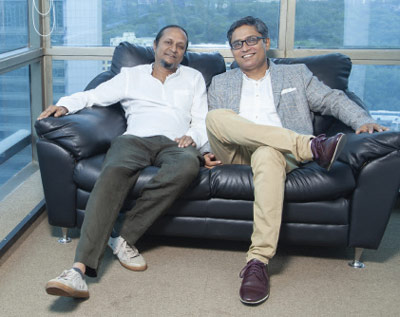 SMELLS LIKE TEAM SPIRIT...
SMELLS LIKE TEAM SPIRIT...Rahul Jauhari, Joint President & Chief Creative Officer and Navonil Chatterjee, Joint President & Chief Strategy Officer of the newly independent Rediffusion Group talk to Srabana Lahiri about redefining aggression at work, their intense creative process and the challenge of offering integrated solutions to clients
They complete each other’s sentences. They throw around Bong witticisms with deadpan faces. They also have a three-year partnership at Rediffusion that has resulted in big business wins - Tata 150 year celebrations, Tata Trusts, State Bank of India, German brand Liebherr, Rising Pune Super Giants and Jamshedpur Football Club, amongst others - and some brilliant creative work on brands. While Rahul Jauhari, Joint President & Chief Creative Officer, and Navonil Chatterjee, Joint President & Chief Strategy Officer of Rediffusion epitomize the have-fun-while-you-work motto, they are absolutely serious when it comes to carrying forward Diwan Arun Nanda’s just-announced credo of aggression on all aspects of the business.
“We may be softies at heart with people and things like that. However, when it comes to work, it’s all clearly defined. Our aggression means being a lot more forceful about our point of view, and being able to command the right kind of premium for our work. One thing that both of us are very clear about is that we will not sell our services cheap; we will choose clients more carefully, not go for rampant pitching,” says Jauhari, who has spent 14 years with the Rediffusion Group in two stints. “Mr Nanda has always been known to be a man with absolute spine. For us too, spine counts in a lot of places – our stance with clients, stance with team, stance with the industry... We bat front foot with our clients, we bat purely on our work.”
Chatterjee quotes Jane Austen here. “It is how Jane Austen says, ‘Darcy has no improper pride’. We believe in having that proper pride when we walk into a client’s office or talk to people. That is quiet aggression.”
CHANGES ON THE GROUND
So what has changed in the company now that it is independent? “There are two levels of change. One is at the stakeholder level. Now we have the room and the flexibility to steer the company in the direction we want to. We don’t need to ask anyone. The onus obviously lies on us to expand the business and make more money, though Mr Nanda never mentions money. All he says is, ‘Guys, let’s do some great work.’ To enable great work in today’s time requires not just the insight that naturally comes to him or the creativity that naturally comes to me, but also an understanding of the market and the mediums. That’s changing. We need to tackle that, provide solutions to clients’ problems. So, a part of the post-buyback scenario is also that we work a lot more closely with rediff.com, on the technology side,” says Jauhari.
For Chatterjee, there are no set targets to achieve, just his boss’s confidence that business will always come. About 30-35% of the agency’s revenue comes from new business, he says, and the rest is organic growth. “If you look at new business in the last six months, SBI makes up a big chunk, Tata is a big chunk. Each one has been fought and won. In some cases like Tata, it’s not just about increasing the same business; it’s completely new divisions of Tata coming to us - an entirely different category, an entirely different client,” he adds.
While Parle, one of the agency’s oldest clients, now treats each big campaign as a project, and has a pitch for it, Rediffusion has got a majority share of Parle’s work. “They have a roster of three-four agencies. Ultimately, it’s the better idea that wins,” says Jauhari. Chatterjee mentions the agency’s latest work on Parle 20-20: “Obviously that’s a project we won and we are very happy with that work, where a biscuit conversation has been lifted to a higher level of positive, progressive thinking that you can associate with the brand.”
That the creative team works very closely with planning works well for them both. “Our usual approach is to say that we are not advertising because an ad is needed, we are advertising because the client has a problem. Let’s find a way to solve the problem. The answer could be a banner, it could be a campaign, it could be a film, it could be an event, it could be a mobile solution or whatever, but it starts with a problem. If you recognize the problem, well, you will come up with a solution,” Jauhari explains.
What is also going to happen is greater integration with verticals such as Rediffusion Direct and Rediffusion Healthcare, which functioned pretty independently until now. “That collaboration is already happening. We are planning to go for a certain client meeting as a fully integrated team, which was not the case 15 days back. So, this is how we will actively and consciously approach clients now. That’s the effect of being an independent agency,” Chatterjee says.
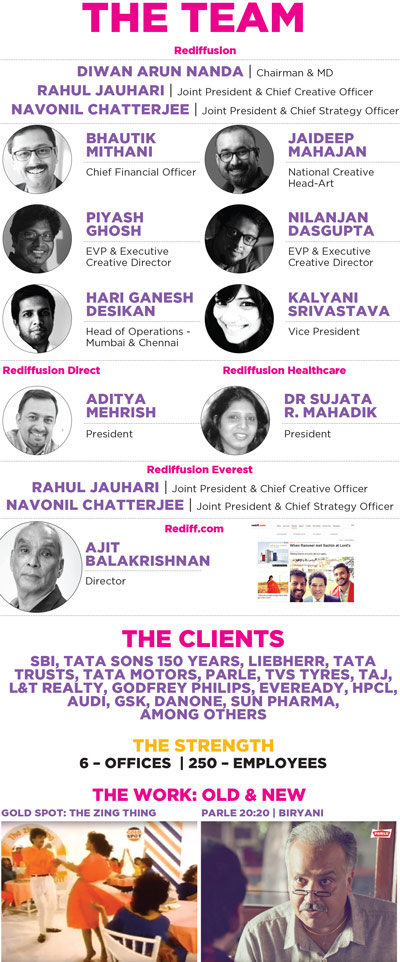 THE CREATIVE EXERCISE
THE CREATIVE EXERCISEThe creative exercise at Rediffusion begins with long conversations – and something fruitful usually emerges at the end. “All of us have ideas. What is of more consequence is zeroing in on the correct idea. Once the idea has been picked, the rest will flow freely. After that, it needs to be very collaborative. And that’s the part which really interests me, how you can pick an idea and then watch it flourish. There is no structure to the process or rule book for cracking a great idea. My national creative director sometimes calls me at 12:30 am saying he has an idea. It’s like a little boy at work. When an idea comes, you get excited,” says Jauhari.
There is also excitement in the way things happen. Once the team had gone for a pitch for LG Ultra in the South. Once the pitch was over, they went for a movie. “Barely a few minutes into the film, we got a call from the client to say that we had won the business and whether we could return right away. So we went back. This was in Coimbatore,” remembers Jauhari.
Meanwhile, both Chatterjee and Jauhari are intent on making work at Rediffusion more fun. “We are trying to do a lot of things internally for training that doubles up as fun,” says Chatterjee. “We do things which energize people within the agency, train them to do their jobs better, and this could be from writing briefs to appreciation of what the problem is, to the art of presentation. We are in the business of selling, so all of us need to get better at what we sell. We are running a section called ‘PPT’ - Passion, Presentation and Training. We have volunteers every week to talk for 15 minutes on what they are passionate about after which the rest of the audience gives constructive feedback on the content, body language, etc. And everybody learns in the process. Sometimes we talk of very basic things - say a wide format versus a vertical format on a mobile screen, even those things matter. In the process, we create the right vibe and the right kind of energy around this place.”
Talking about some upcoming work from the agency, and his 45-strong creative team, Jauhari says, “Apart from Parle 20-20, we are doing some significant work with SBI for digital banking. That will be rolled out in a few weeks. For Tata, we are working on the 150th year campaign, including its technology side. The portfolio looks rich for the year. In the South, we have just put out a campaign for TVS Tyres. We also have Tata Motors as a client for commercial vehicles.” The agency has also associated with the Wrestling Federation for upcoming campaigns.
THE CHALLENGES AHEAD
Jauhari and Chatterjee are quite confident about the team they have put together in the last couple of years. That part of the challenge is done and taken care of, they say. According to them, there are significant wins in their kitty, the kind of work they do is appreciated and in turn gets them more work. So, the only challenge is to scale it up. Going back to stakeholder discussions, they want to say that they have the capability to evolve with different kinds of solutions. “The challenge is to integrate across our offerings, whether it’s direct, CRM, or digital, we have the backend support of rediff.com. We don’t always have to offer everything to everybody, but what we aim for is that Rediffusion becomes the one-stop answer to what the client is seeking. Therefore, they don’t need to go out of Rediffusion,” says Chatterjee. According to Jauhari, the agency has already been offering technology-based solutions to some clients, and he hopes to absorb it into the mainline work more and more.




